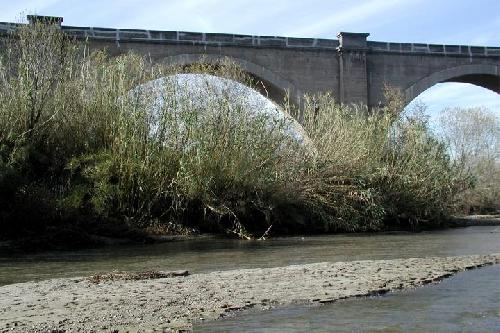CHAMPAIGN, Ill. -- Arundo donax, a giant reed that grows in the Mediterranean climate zones of the world, isn't like other prolific warm-weather grasses, researchers report. This grass, which can grow annually to 6 meters (nearly 20 feet) in height, uses a type of photosynthesis that is more common to crop plants like soybeans, rice and peanuts.
The new findings are published in Scientific Reports, a Nature publishing group journal.
"Most highly productive grasses, like sugarcane, miscanthus and switchgrass, use these types of photosynthesis called C4, which we know to be very efficient," said study leader , a professor of crop sciences and of plant biology at the University of Illinois. "We confirmed that giant reed uses C3, a less efficient type of photosynthesis, and yet it's really productive. We just had to find out how."
 Arundo donax, also known as giant reed, grows abundantly in the Mediterranean climate zones of the world. Researchers found it has optimized C3 photosynthesis. Credit: Photo by Lauren Quinn
Arundo donax, also known as giant reed, grows abundantly in the Mediterranean climate zones of the world. Researchers found it has optimized C3 photosynthesis. Credit: Photo by Lauren Quinn
The new findings could help scientists improve C3 photosynthesis in other plants.
Only a few detailed studies have evaluated the productivity of Arundo donax, "but some studies suggest it could produce as much as 60 tons of dry matter per hectare," Long said. "That's about the maximum you'd ever see from Miscanthus x giganteus, also known as giant elephant grass, a C4 grass that, as its name suggests, is considered very productive."
For this reason, Arundo donax has attracted attention as a potential bioenergy crop despite questions about its invasive tendencies.
In the new study, the researchers focused on a naturally growing stand of Arundo donax in a mixed, five-acre site in southern Portugal. They measured how quickly the grass took in carbon dioxide and lost water through the pores in its leaves, the amount of chlorophyll in the leaves, how much light upper and lower leaves received or reflected, and how efficiently they photosynthesized in high- and low-light conditions.
These measurements offered insight into some of the factors that make the plant so productive.
"We found first of all that it is a classical C3 plant. It has all the properties of C3 photosynthesis and none of those of C4," Long said.
"It produces a lot of leaves, and while the top leaves are getting a lot of sunlight, the lower leaves are shaded," he said. "We found that the plant's shade photosynthesis is very efficient, so the lower leaves are producing a lot of chlorophyll to capture what light is getting to them, and the plant is using that at maximum efficiency."
In C3 plants, the enzyme that catalyzes the uptake of carbon dioxide is known as Rubisco.
"We found that in Arundo donax the activity of Rubisco in the intact leaf was exceptionally high, as was its capacity to generate the reductant that biochemically reduces the assimilated carbon dioxide to carbohydrate," Long said.
The researchers also found that, contrary to their expectations, Arundo donax used no more water per unit of carbon absorbed into its tissues than other C3 plants, Long said. Some had suggested that it boosted photosynthesis by opening the pores in its leaves very wide, taking in a lot of carbon dioxide but also wasting water. Other C3 plants, like some cotton cultivars that rely on irrigation, do this, Long said. They are productive, but have low water-use efficiency because they lose a lot of water through their leaves.
"Giant reed is a deep-rooting plant, so it's able to get plenty of water. But it's not using that water any less efficiently than other C3 plants," Long said.
"What we were really investigating here was the scientific question: How does this plant achieve this high productivity?" he said.
Some had suggested that the plant uses C4 photosynthesis or that it achieves its high productivity by guzzling water, he said. But the new study establishes that neither hypothesis is true.
"We're obviously excited that we've finally settled this mystery," he said.
Stephen Long is a researcher in the Carl R. Woese Institute for Genomic Biology at the U. of I.
source: University of Illinois at Urbana-Champaign